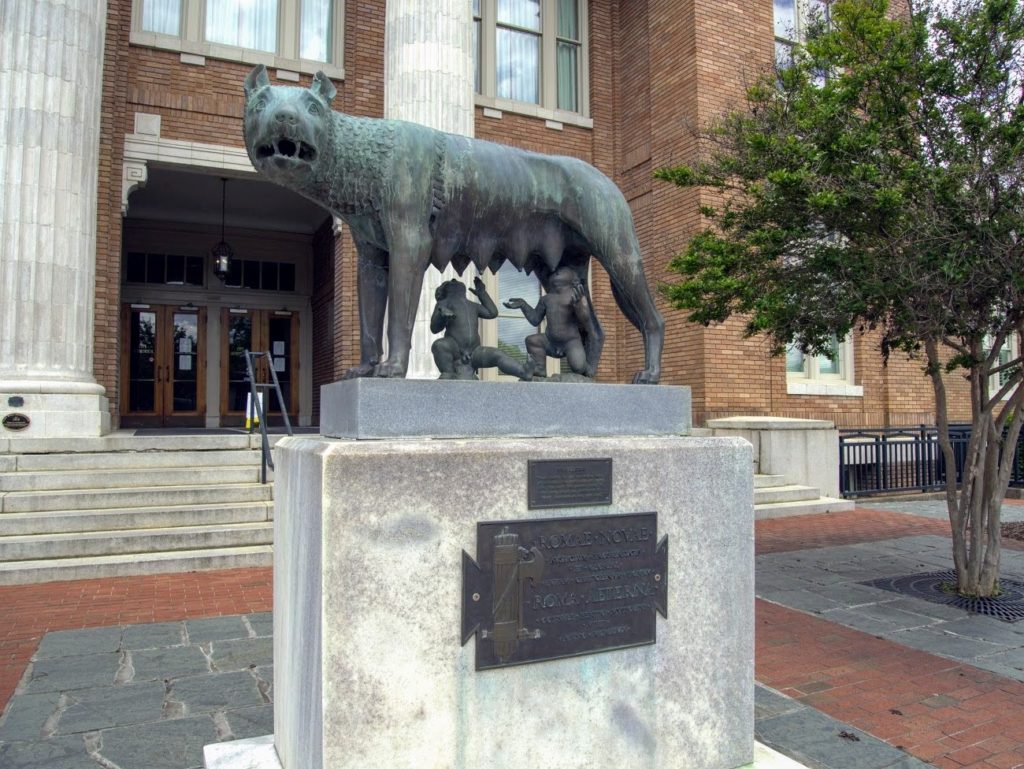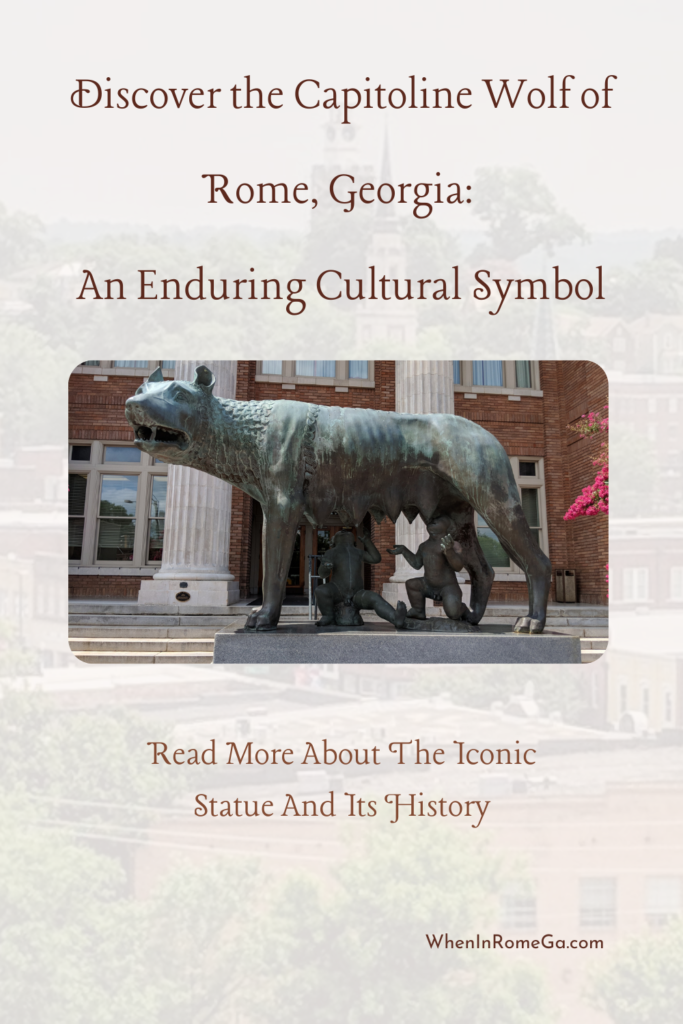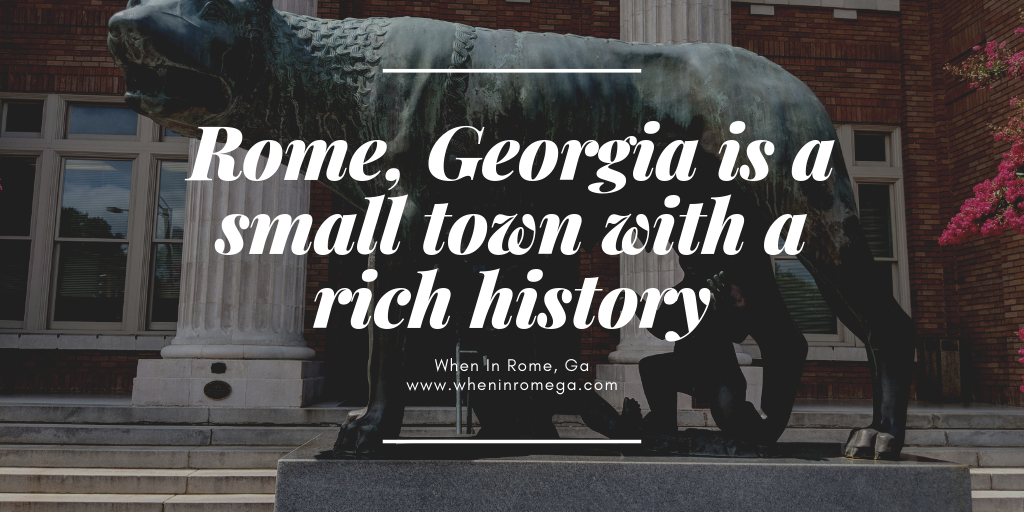The city of Rome, Georgia is known for many things – its charming downtown area, its rich history, and its iconic Capitoline Wolf statue. It is a replica of the Etruscan art in the Palazzo dei Conservatori on Campidoglio (Ancient Capitoline Hill) in Rome, Italy. The statue is more than just a mere sculpture; it represents the city’s identity and is a cultural icon passed down through generations. The statue depicts the Capitoline Wolf suckling Romulus and Remus, the founders of Rome after their parents abandoned them.
In this blog post, we’ll journey through time and explore the fascinating history of the Capitoline Wolf – from its ancient origins to its modern-day significance. We’ll delve into its legend, learn about its arrival in Rome, Georgia, and examine how it symbolizes the city’s identity. Finally, we’ll discuss the legacy of the Capitoline Wolf and why it’s such a significant cultural icon for locals and visitors alike. Whether you’re a resident of Rome or just passing through, join us as we discover the rich cultural history surrounding the Capitoline Wolf.
The Legend of the Capitoline Wolf
According to legend, the Capitoline Wolf has an ancient origin story steeped in mythology. The story goes that the twin brothers, Romulus and Remus, were abandoned as infants and left to die in the wilderness. However, the brothers were saved by a she-wolf who nursed and raised them as her own. Eventually, the brothers founded the city of Rome, with Romulus becoming its first king. The Capitoline Wolf statue depicts this iconic legend, with the she-wolf standing proudly with the twins at her side.
With such a rich and fascinating backstory, it’s little wonder that the Capitoline Wolf became an important cultural symbol for the people of Rome, Georgia. Italian dictator Benito Mussolini gifted the statue to the city in 1929 as a gesture of goodwill between the two nations. The statue has since become a beloved and iconic fixture in the city, drawing tourists and locals to its impressive presence.
Next, we’ll look closer at the arrival of the Capitoline Wolf in Rome, Georgia, and examine how it became an important part of the city’s identity.

The Arrival of the Capitoline Wolf in Rome, Georgia
The Capitoline Wolf statue is made of bronze and weighs over 1,500 pounds. It has become a cultural icon for the city, drawing visitors from around the world. But how did this iconic statue arrive in Rome, and what led to its enduring significance in the community? The history of the Capitoline Wolf in Rome, Georgia is rooted in the friendship between Italy and the United States, which dates back over a century. Italian dictator Benito Mussolini gifted the statue to the American people when Chatillion Corporation Silk Mills of Milan, Italy relocated to Georgia’s Rome in 1929 as a symbol of goodwill and cultural exchange.
The inscription on the statue reads as follows:
“THIS STATUE OF THE CAPITOLINE WOLF AS A FORECAST OF PROSPERITY AND GLORY HAS BEEN SENT FROM ANCIENT ROME TO NEW ROME, DURING THE CONSULSHIP OF BENITO MUSSOLINI, IN THE YEAR 1929”.
The statue was installed in Rome, Georgia, named for the Italian capital because of the similarities between the two cities. The Capitoline Wolf was initially located in front of Chatillion Corporation Silk Mills. It was moved to its current location in front of the Rome City Auditorium or City Hall in 1952. It quickly became a cherished symbol of the city’s identity. Today, the Capitoline Wolf remains an enduring testament to the bond between these two nations and the enduring importance of cultural exchange. In the next section, we’ll explore how the statue has become a cultural touchstone for the people of Rome, Georgia, and examine the legacy of this iconic symbol.
The Capitoline Wolf as a Cultural Icon
The Capitoline Wolf in Rome, Georgia has transcended its origins as a gift from a foreign country to become a beloved cultural icon for the city. Its image can be seen on everything from local government stationery to school mascots. Its likeness is even incorporated into the city’s official seal. The statue symbolizes the city’s unique identity, representing the melding of Italian and American cultures. The Capitoline Wolf has also become a source of pride for the people of Rome, Georgia, who often point to it as evidence of the city’s rich history and cultural significance. As we delve deeper into the legacy of this iconic statue, we’ll explore how it has continued to shape the identity of Rome, Georgia and the broader American South.
The Legacy of the Capitoline Wolf
The Capitoline Wolf has left a significant legacy in Rome, Georgia, and beyond. Beyond its status as a cultural icon, the statue has become a powerful symbol of the city’s unique identity. It has become a source of pride for the people of Rome, who often cite it as evidence of the city’s rich history and cultural significance.
The statue’s legacy extends beyond the city limits of Rome, Georgia. It has become a symbol of the broader American South, representing its deep roots and the intersection of different cultures. The statue holds special meaning for Italian Americans, symbolizing their heritage and contributions to American society.
The Capitoline Wolf has also played a role in shaping the future of Rome, Georgia. It has become a beloved fixture of the city’s landscape. The statue is a popular spot for weddings and other special events. Its image is used to promote tourism and economic development. The statue has been featured in countless advertisements, brochures, and promotional materials, and it continues to draw visitors from all over the world.
Perhaps most importantly, the Capitoline Wolf has become a source of inspiration for generations of Rome, Georgia residents. It is a powerful reminder of the city’s rich history and cultural heritage. It inspires people to think creatively and embrace new ideas. As the statue stands tall in the heart of Rome, it will undoubtedly inspire new generations of residents and visitors alike.
In conclusion, the Capitoline Wolf’s rich history has become a cornerstone of Rome, Georgia’s cultural identity. Its legend stretches back to ancient times. Its arrival and subsequent transformation into a cultural icon have cemented its place in the city’s legacy. Whether you’re a local or a visitor, taking a moment to appreciate the statue’s significance will deepen your understanding of the city and its history. As the Capitoline Wolf continues to inspire and captivate, we are reminded that cultural symbols hold an enduring power that can bring us together and transcend time. So next time you find yourself in Rome, Georgia, take a stroll past the Capitoline Wolf and remember the rich cultural legacy it represents.
Read our post on the Historical Tour Of Broad Street for more historical markers in Rome, Georgia. Broad Street is one of the most popular places people go “When In Rome, Georgia.” It has the best collection of food, shopping, and entertainment venues in and around Rome. You may not know how a Broad Street tour reveals our rich local history. If you start at one end of Broad Street and stroll to the other end, you will find some fantastic stories and the history of our town.

Sign up for our email list to receive The Ultimate Bucket List For When In Rome, Georgia; you will never miss out on news about When In Rome, Georgia.




